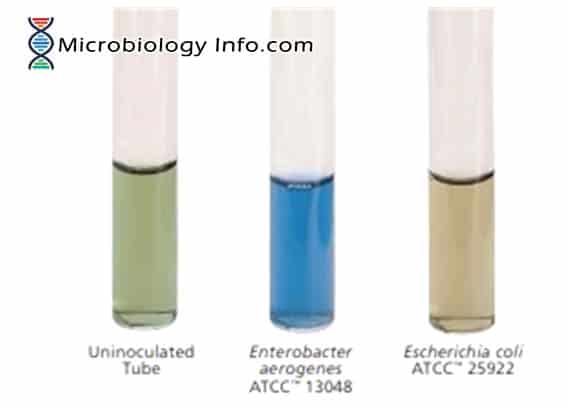Malonate test is a colorimetric test of the ability of bacteria to use malonate as a source of carbon, the endpoint of which is the production of alkaline metabolites that induce a color change.
Objectives
- To test the ability of the organism to utilize malonate as sole source of carbon and energy for growth.
- To differentiate organisms on the basis of malonate utilization.
Principle
An organism that simultaneously can utilize sodium malonate as its carbon source and ammonium sulfate as its nitrogen source produces an alkalinity due to the formation of sodium hydroxide.
This results in an alkaline reaction which in a medium containing malonate, changes the indicator (bromothymol blue) from its original green color to light blue or Prussian blue. Organisms which cannot utilize malonate and ammonium sulfate and do not ferment dextrose produce no color change.
Organisms which are malonate-negative but do ferment dextrose result in the development of a yellow color due to increased acidity in the medium.
In the lab, an inoculum from a pure culture is transferred aseptically to a sterile tube of malonate broth.
The inoculated tube is incubated at 35-37 C for 24 hours and the results are determined. Abundant growth and a change from green to blue in the medium indicates a positive test for growth using malonate. Hence, if a microbe can use malonate for carbon and energy, it will grow on malonate broth. The use of malonate leads to a rise in pH of the medium, and a pH indicator changes color.
Media:
The medium used is malonate broth. Malonate Broth, prepared according to the formula described by Leifson, is a liquid medium containing ammonium sulfate as the only source of nitrogen and malonate as the only source of carbon .It contains mineral salts, sodium citrate for carbon, and ammonium phosphate for its nitrogen source. The pH indicator is brom thymol blue, which is green at neutral pH, yellow at acidic pH <6.0 and turns blue at alkaline (basic) pH >7.6.
Ingredients Gms / Litre
Ammonium sulphate 2.000gm, Dipotassium phosphate 0.600gm, Monopotassium phosphate 0.400 gm, Sodium chloride 2.000 gm, Sodium malonate 3.000 gm, Bromothymol blue 0.025 gm
Final pH ( at 25°C) 6.7±0.2
Procedure
- Using a light inoculum from an 18-24 hour pure culture, inoculate the tube containing malonate broth.
- Incubate the tube with loosened caps at 35ºC in an aerobic atmosphere for 24-48 hours.
- Observe for alkalization (blue color) at 24 and 48 hours.
Results
- A positive malonate test is indicated by the development of a blue color in the medium.
- A negative malonate test is indicated by the media remaining green or turning yellow due to dextrose fermentation.
Uses
- The Malonate Test was originally designed to differentiate between Escherichia and Enterobacter.
- Its use as a differential medium has now broadened to include other members of Enterobacteriaceae.
- The malonite reaction can be used todifferentiate among Enterobacteriaceae: Klebsiella pneumoniae is positive (blue at 24 hours), Escherichia coli is negative(culture remains green).
- The test can also be used to separate Salmonella arizonae (positive) from other Salmo ella spp(negative).
- In differentiating Enterobacteriaceae in food and dairy products.
Limitations
- It is recommended that biochemical, immunological, molecular, or mass spectrometry testing be performed on colonies from pure culture for complete identification.
- Some malonate-positive organisms produce only a slight alkalinity which renders difficulty in interpretation.
- Some malonate-negative strains ferment glucose only and produce a yellow color in the medium.
- A slight bluing (blue-green) of the medium may occur after prolonged incubation.
References
- https://catalog.hardydiagnostics.com/cp_prod/content/hugo/malonatebroth.htm
- www.vumicro.com/vumie/help/VUMICRO/Malonate_utilization_Test.htm
- www.bd.com/europe/regulatory/Assets/IFU/Difco_BBL/239520.pdf
- https://assets.thermofisher.com/TFS-Assets/LSG/manuals/IFU61324.pdf
- atlas.sund.ku.dk/microatlas/veterinary/pheno_tests/Malonate_Test/
- www.interlabdist.com.br/dados/produtos/bula/doc/1713148ff81d57aae4.pdf1
- https://himedialabs.com/TD/M382.pdf
Similar Posts:
- The Triple Sugar Iron (TSI) Test – Principle, Procedure, Uses and Interpretation
- Simmons Citrate Agar- Composition, Principle, Uses, Preparation and Result Interpretation
- Oxidase Test- Principle, Uses, Procedure, Types, Result Interpretation, Examples and Limitations
- Bile Solubility Test- Principle, Reagents, Procedure and Result Interpretation

